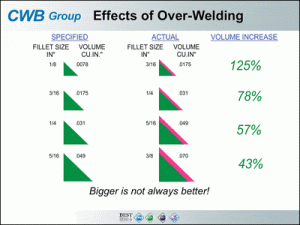So many shops operate under the premise that the bigger the weld the better it is, or that putting down a bigger weld than what is called for is playing it safe. Although there may be some truth to this it isn’t always the case. And, in some instances, a bigger weld can actually be detrimental to the mechanical integrity of the welded assembly. Our focus today is simply to talk about the cost of over welding. The example below will show how “playing it safe” with a bigger weld can be costing your company a lot of money.
Example: ABC, Inc. has a welded assembly that consists of 37 welds. These are 3/16” fillets, all of which are 10 inches long. Current production puts out 50 assemblies per day. Welding is done with an .045 ER70S-6 wire at 350 inches per minute using 90/10 gas. After careful examination it is discovered that the welds consistently measure at 1/4”. The weld does not look that much bigger so the assumption is it doesn’t slow anybody down and it is a stronger weld. Once again, our focus is on cost. Let’s talk a look.
Total inches of weld per day = (37 welds/part) x (10 inches/weld ) x 50 parts = 18,500 inches
Total weld metal used (at 3/16 fillet) = (18,500 inches) x (0.00638 lb/inch of 3/16” fillet) = 118.07 LB
Total weld metal used (at 1/4 fillet) = (18,500 inches) x (0.01135 lb/in of 1/4” fillet) = 209.91 LB
We will spare you the details of the calculation, but we essentially determined the volume of weld needed and use the density of steel to calculate total weld required. We use a formula that allows for a convex bead contour which adds to total volume. We also assume an electrode efficiency of 95%.
So as you can see an increase of 1/16 inch on fillet size leads to an increase in weld metal use of a whopping 77.8%!
A simple way to measure your fillet welds is to use a 7 Piece Fillet Weld Gage Set
You can see the image below taken from the Canadian Welding Bureau website. Showing percentage increases in weld metal when going from one size to the next.
Crushing Effect to Bottomline:
So ABC Inc is using roughly 92 extra pounds of mig wire per day. At a cost of $2.20/lb and assuming 50 working weeks per year this totals 23,000 extra pounds or $50,600 in additional costs. But wait, it gets worse. Labor and over head is the biggest component of total cost (usually). Let’s assume a L&OH rate of $55/hr for ABC Inc.
Welding at 350 inches per minute with an .045 diameter ER70S-6 wire we can deposit 8.82 lb/hr. This means that if we stick with 1/4 fillet welds we would need 52,477 LB which at 8.82 lb/hr would take 5,949 man hours. At a rate of $55/hr this totals $327,240/yr. You can determine the deposition rate of any solid wire by using this simplet formula.
Deposition Rate = 13.1 (D²) (WFS)(EE)
If welds are kept at 3/16 fillet the total pounds used per year total 29,517. At 8.82 lb/hr it only requires 3,346 man hours, or $184,066 in L&OH. This means that that slighly bigger fillet weld is costing ABC around $143,173/yr. Add the material cost and we are almost at $200,000!
Even if ABC Inc only over welded 25% of their welds, this is still an additional cost of almost $50,000.
A $25 investment on a fillet gage may be worth it after all.
This article covered the topic of overwelding due to lack of procedure control. But what happens when you need to make a weld bigger to compensate for other issues, such as bad fit up? That can get very costly as well – take a look at The Outrageous Cost Of Poor Fit Up.


How hard is it for a welder to be able to determine how big the weld is as he is welding?
You would be surprised how experienced welders can tell if a weld is 3/16, 1/4, 3/8, etc. Some of it has to do with the ability of the welder to watch the puddle and gage the size of the weld. However, the most common response we get when we ask how they do it has to do with the ability to gage their travel speed. Muscle memory plays a big role. If a welder is constantly doing different welds of different sizes it may be a hard, but when most of his or her welding is done at a specific size they start learning how to gage weld size. Some welders, if they have to up the size of their weld, they simply turn up their wire feed speed and travel at the same rate. Others slow down. It is amazing how some seem to never even need a fillet gage.